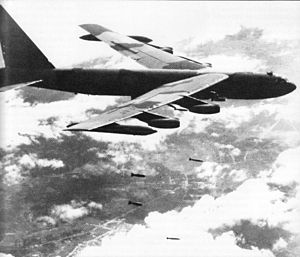Linebacker II
| Operation Linebacker II | |||||||
|---|---|---|---|---|---|---|---|
| Part of the Vietnam War | |||||||
 B-52 Stratofortress on bomb run |
|||||||
|
|||||||
| Belligerents | |||||||
|
|
|
||||||
| Commanders and leaders | |||||||
|
John Dale Ryan John W. Vogt, Jr. John C. Meyer |
Phung The Tai Le Van Tri |
||||||
| Strength | |||||||
| 207 B-52s 2,000 tactical aircraft |
14 SA-2 batteries 100+ aircraft AA gun units |
||||||
| Casualties and losses | |||||||
|
US claim: PAVN claim: 81 aircraft shot down (including 34 B-52s and 4 F-111s; this includes two B-52s shot down by MiG-21 fighters) |
1,624 civilians killed Military casualties are unknown U.S claim: 6 MiG-21s shot down (including 2 MiG-21s shot down by B-52 tail gunners) PAVN claim: 3 MiG-21s shot down |
||||||
US claim:
12 tactical aircraft shot down
16 B-52s shot down
4 B-52s suffered heavy damage
5 B-52s suffered medium damage
43 killed in action
49 taken prisoner
Operation Linebacker II was a US Seventh Air Force and US Navy Task Force 77 aerial bombing campaign, conducted against targets in the Democratic Republic of Vietnam (North Vietnam) during the final period of US involvement in the Vietnam War. The operation was conducted from 18 to 29 December 1972, leading to several informal names such as "The December Raids" and "The Christmas Bombings". Unlike the Operation Rolling Thunder and Operation Linebacker interdiction operations, Linebacker II was to be a "maximum effort" bombing campaign to "destroy major target complexes in the Hanoi and Haiphong areas, which could only be accomplished by B-52s". It saw the largest heavy bomber strikes launched by the US Air Force since the end of World War II. Linebacker II was a modified extension of the Operation Linebacker bombings conducted from May to October, when the emphasis of the new campaign shifted to attacks by B-52s rather than smaller tactical fighter aircraft.
On 8 October 1972, U.S. National Security Advisor Dr. Henry Kissinger and North Vietnamese Politburo member Le Duc Tho met in Paris to discuss new proposals by both nations, hoping to reach mutually agreeable terms for a peace settlement for the decade-old Vietnam war. Tho presented a new North Vietnamese plan which included proposals for a cease-fire, the withdrawal of American forces, and an exchange of prisoners of war. All three Vietnamese combatant governments—North Vietnam, the Republic of Vietnam (South Vietnam), and the Provisional Revolutionary Government of South Vietnam (PRG)—would remain intact, as would their separate armies. Hanoi no longer demanded that South Vietnamese president Nguyen Van Thieu be removed from office, the U.S. did not have to cease its aid to the southern government, and both Washington and Hanoi could continue to resupply their allies or forces on a parity basis. No new North Vietnamese forces were to be infiltrated from the north, and the U.S. agreed to extend post-war reconstruction assistance to North Vietnam.
...
Wikipedia
